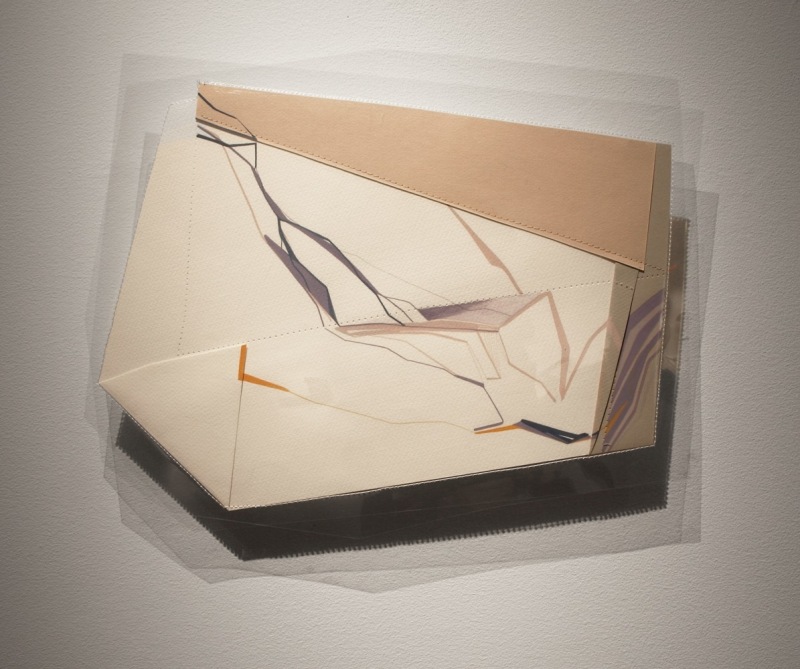
Toss, Sheila Makhijani's third solo at Talwar Gallery, New York, from the 13th of November, 2010 to the 22nd of January, 2011, invited the viewer into delicate graphic worlds, which felt like they'd been drawn by a Mughal miniature master plopped into the digital age. Somewhere between topographical map and biological diagram, these works cofounded the viewer, especially her/his sense of scale and perspective. There was something refreshing about their strange, careful lines. This was abstraction with a lower case 'a' - deceptively simple, unlike the identity-driven Conceptualism that rules the Indian art scene. Toss bore witness to the work of a serious, mid-career artist who is committed to a unique vision of whimsy and couldn't care less about being in fashion.
The show consisted of two distinct sets of gouache works on paper as well as an artist's book. The walls of the first room were lined with petite two-dimensional works, each 17 1/2 inches x 14 3/8 inches. Some, like I saw that first! were compact and harmonious, evoking the crepuscular contours of a mountainside. I would like to spot something like that on the horizon! Others had a little more compositional tension. Ok, Ok, Now Stop Right There!, for instance, featured two distinct forms that managed to evoke aggression. They were jagged and hollow - the protruding edges of the smaller one were angled into the toothy grin of the larger one. The picture suggested that the two shapes were far from delighted at the prospect of their implied collision and the title, though expressive, was hardly explicative.
The gallery's second room contained similar work, albeit endowed with a third dimension. Folded and laminated paper forms stitched together with cotton thread offered unusual lines and figures that jumped off the wall. The spatial transition - from drawings to three-dimensional works - felt a bit jarring, but it also pointed to a shift in Makhijani's practice. In fact, the forms in her two-dimensional works have often implied mass and volume.
In Come on... Come on... Move it! Move What! That, That What! You Know What! the dramatic fold at the top left corner, which fell towards the viewer, echoed the abstract mountain landscape on the flat picture plane. It cast a heavy shadow over nearly half the drawing, and could potentially irritate a purist who might wish for a less obstructed view of the brushwork. The exclamatory title made a tongue-in-cheek at the picture's peculiarity.
The transition from two to three dimensions and the shadow play that resulted out of it animated the artist's book, Do It Like This, which stood dramatically in the corner of the gallery. The book was an ungainly object, with pages of laminated paper stitched stiffly together with the same cotton thread that was used in many of the other works. This project clearly required a good deal of planning. Each page related to the one adjacent to it and, often, a single line extended across two pages or a bulbous organic form that began on one leaf achieved closure on the other. Since each of the pages would need to be 'completed' before the plastic coating was sewn on and the final book was 'bound', the correspondences would have had to be planned out well in advance. Apart from the visual interplay of the lines and the planes, this project was not very engaging. This stiffness of the plastic felt more structural than book-like. So, I was left wondering what really had been gained by taking these sheets off the wall in the first place.
The viewer would be hard-pressed to identify in these works the hallmark Indianisms that abound in the work of Makhijani's peers. Makhijani does carry forward, however, the oft-ignored tradition of Indian Minimalism as exemplified by the compelling drawings of Nasreen Mohamedi. Makhijani's training at the Kanazawa Bujutsu Kogei Daigaku, Kanazawa, Japan, is also evident in her precise, almost calligraphic compositions. While Japanese artistic traditions haven't influenced many contemporary Indian artists, they have inspired the painters of the Bengal School and therefore, are of definite if underrated significance of the history of Indian modernism.
Toss did not represent a major departure from Makhijani's earlier work; some of the concerns expressed in her work over the last decade, surfaced here too. That said, works from the early 1990s were more compelling than the works in Toss - they seemed to contain energy that pressed inwards rather than explode out.
By the time Makhijani had had her first solo at Talwar Gallery in 2004, she was already experimenting with three-dimensionality. Her notable installation, Butputs (2003), composed of dozens of painted acrylic cubes, was very structural and signaled her first foray into shadow play. In 2005, Makhijani's picture plane was populated with exuberant, looping forms - a sort of flirtation with abstract horror vacui. She quickly retreated from these experiments, however, and her work seems now to have come full circle. She is back to her contained forms, albeit with sharper edges and greater tension. While Toss did not quite dazzle me, I left the gallery moved by these intimate and original worlds that were constructed with talent and feeling.
-Sophia Powers